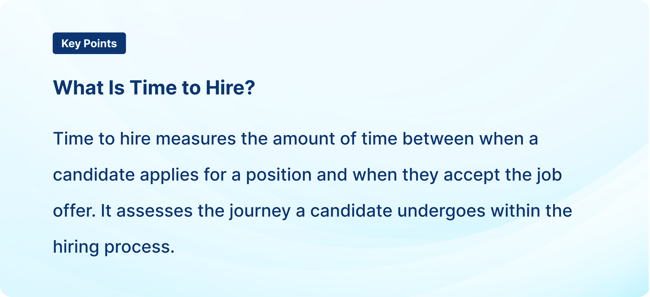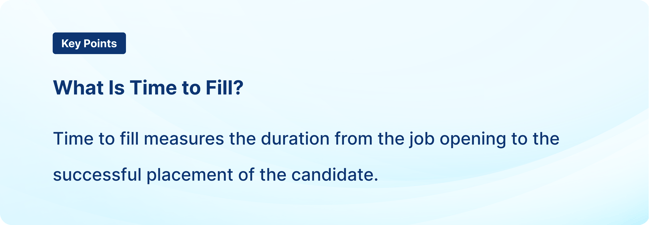

In today's competitive job market, understanding time to fill is paramount for organizations aiming...

One of the biggest challenges for hiring managers in developing a hiring strategy is not actually knowing whether it’s working.
You may notice issues such as delayed recruitment cycles or increased hiring costs, but you don’t always know the cause. Or, worse, you're missing out on opportunities to hire top talent, all of whom go to your competitors.
Below, we compare each metric’s nuances and discuss using time to fill vs. time to hire. We also offer guidance for selecting the most appropriate metric for more efficient recruiting strategies. Let's get started!
Key TakeawaysHere are the key differences between time to hire and time to fill:
|

Time to hire measures the amount of time between when a candidate applies for a position and when they accept the job offer. It assesses the journey a candidate undergoes within the hiring process. The steps in time to hire may include:
Time to hire shows how efficient your hiring process is. It provides insights into how quickly you identify, assess and secure suitable candidates. It starts when a candidate formally expresses interest in a job opportunity by submitting their application. From there, it includes every stage of the recruitment life cycle.
The metric does not consider the time taken to create a job posting or planning before a position is open. Instead, it focuses solely on the time it takes to move a candidate through the hiring pipeline.
Time to hire is a core performance indicator that reflects the efficiency of your recruitment strategy.
The calculation begins when a candidate formally applies for a position and concludes when they accept the job offer. The formula for calculating time to hire can be expressed as:
Time to Hire = Date of Candidate Acceptance − Date of Application
For example, let’s say a candidate submits their application on January 1st and accepts the job offer on February 1st. The time to hire would be 31 days.
Using the time-to-hire metric benefits your recruiting process in several ways:
Recommended Reading: What You Need to Know About High-Volume Hiring

Time to fill measures the duration from the job opening to the successful placement of the candidate. It includes time spent on the following:
Time to fill evaluates how long your entire hiring process takes, and reflects how efficient your process is. It sheds light on how quickly you identify, attract, and onboard the best candidates.
When you initiate a job opening, a time-to-fill metric tracks how long it takes until you hire a candidate. It's a critical metric for your company to monitor as it directly impacts your ability to respond to staffing needs.
You start with the job posting and end when you hire the candidate. The formula determines the number of days elapsed between the job opening and when the candidate accepts the job offer.
Time To Fill = Date of Candidate Acceptance − Date Job Requisition Opens
For example, if a job posting opens on March 1st, and the selected candidate accepts the job offer on March 28th, the time to fill would be 27 days.
By tracking time-to-fill metrics, you gain valuable insights into the efficiency of your recruitment processes.
Using the time-to-fill metric benefits your recruiting process in the following ways:
Time to fill and time to hire are both metrics that recruiters can use to effectively track and analyze their recruitment processes. There is some overlap between the two, but there are many more differences between them.
Here are the primary ways that time to fill and time to hire are similar:
When comparing time to fill and time to hire, it's imperative to understand the crucial differences between these two metrics:
Related Article: What to Do When a Candidate Fails a Background Check
When considering whether to prioritize time to fill or time to hire metrics, assess your unique needs and organizational priorities. Time to fill offers a comprehensive view of the entire recruitment process, including sourcing, screening and onboarding. It’s important to track if you’re aiming to improve efficiency and candidate experience.
On the other hand, time to hire focuses specifically on the selection process. It may be more suitable if you want to streamline specific aspects of recruitment.
Consider factors such as budget, pre-hire assessment capabilities, implementation capabilities and organizational requirements when choosing which metrics to track. Ultimately, the best choice depends on your unique circumstances and strategic objectives.
Wherever you land on the time to fill vs. time to hire debate, Cisive can help. Our advanced background screening services provide faster candidate evaluations and reduce your company's average time to hire while ensuring a thorough vetting process. Our analytics tools provide valuable insights into recruitment efficiency and candidate sourcing strategies.
Are you ready to streamline your recruitment process and secure top talent efficiently? Start a demo or book a consultation with our experts today.

In today's competitive job market, understanding time to fill is paramount for organizations aiming...

Time to hire is a core metric in the recruitment process. It measures the timeline from when a...

Note: This blog discusses a type of drug panel that removes specific drugs (THC, PCP, etc.) in...